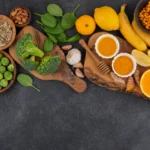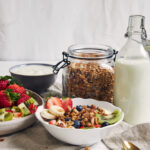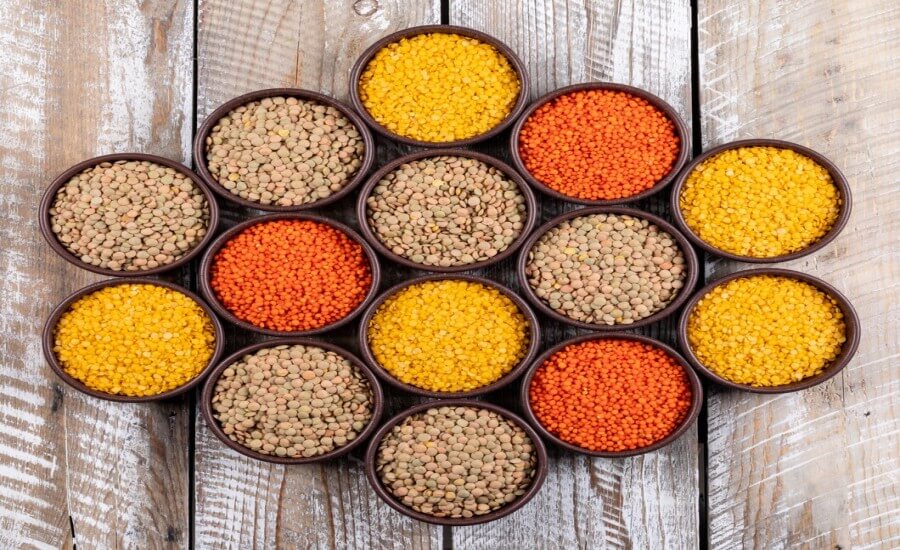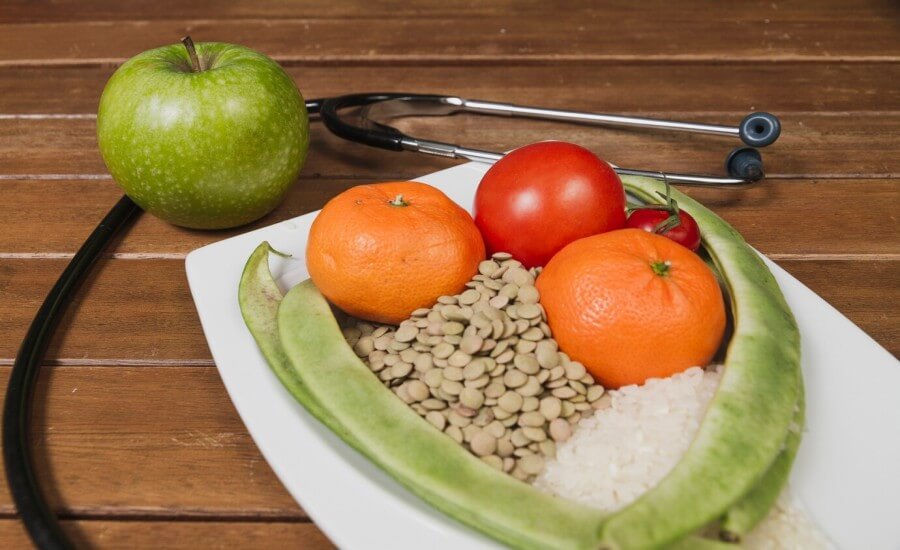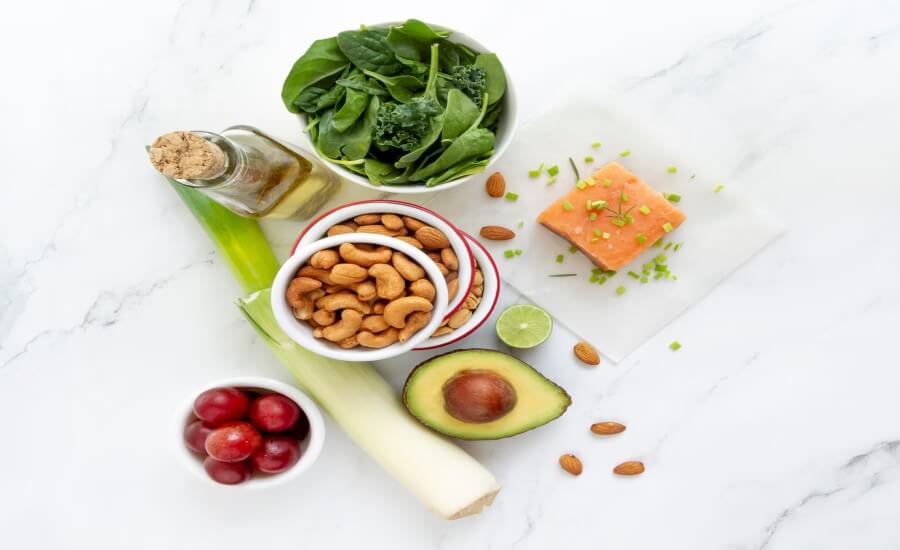In the quest for health, we often focus on vitamins, minerals, and protein. But lurking within the humble cell walls of plants is a true nutritional powerhouse, often underestimated: dietary fiber. For those embracing a vegan or plant-based lifestyle, fiber isn’t just present; it’s abundant, acting as a secret weapon for unlocking incredible health benefits. This analysis explores why “Fiberlicious Vegan” is more than just a catchy phrase. We’ll examine the science behind fiber’s magic through the Nutritional lens, consider its Ethical and Environmental connections, explore the Practical experience of a high-fiber life, and delve into the rich Cultural context of fiber in traditional Indian diets. Prepare to be amazed by the power of plants’ indigestible champion!
LENS 1: Nutritional Science – Fiber’s Multifaceted Roles
- Key Findings: Dietary fiber, exclusively found in plant foods, is crucial for optimal health, extending far beyond digestive regularity. Its benefits, strongly supported by scientific evidence, include promoting gut microbiome health, lowering the risk of heart disease, improving blood sugar control (vital for diabetes prevention and management), aiding weight management, and potentially reducing the risk of certain cancers like colorectal cancer. Plant-based diets, especially those centered on whole foods, naturally excel in providing the high fiber intake linked to these positive outcomes.
- Detailed Analysis:
- The Fiber Spectrum: Fiber isn’t monolithic. The two main categories work synergistically:
- Soluble Fiber: Dissolves in water to form a gel-like substance. Found in oats, barley, dals (lentils), beans, apples, citrus fruits (nimbu, oranges), guava, flaxseeds (alsi), and psyllium husk (isabgol).
- Benefits: Helps lower LDL (“bad”) cholesterol by binding to bile acids, slows down glucose absorption aiding blood sugar control, promotes satiety.
- Insoluble Fiber: Doesn’t dissolve in water. Adds bulk to stool, promoting regular bowel movements and preventing constipation. Found in whole grains (whole wheat atta, millets like bajra/jowar/ragi, brown rice), vegetables (skins, leafy parts), nuts, and seeds.
- Benefits: Essential for digestive regularity, may reduce risk of diverticulitis and potentially colorectal cancer.
- Soluble Fiber: Dissolves in water to form a gel-like substance. Found in oats, barley, dals (lentils), beans, apples, citrus fruits (nimbu, oranges), guava, flaxseeds (alsi), and psyllium husk (isabgol).
- Gut Microbiome Maestro: Fiber is the primary food source (prebiotic) for the trillions of beneficial bacteria residing in our gut. When these microbes ferment fiber, they produce Short-Chain Fatty Acids (SCFAs) like butyrate, propionate, and acetate. These SCFAs are metabolic gold: they nourish colon cells, strengthen the gut lining (preventing “leaky gut”), reduce inflammation throughout the body, improve mineral absorption, regulate immune function, and even communicate with the brain (gut-brain axis). A diverse, high-fiber diet cultivates a thriving gut microbiome, crucial for overall health.
- Cardiovascular Guardian: Soluble fiber actively lowers cholesterol. Additionally, high-fiber diets are associated with lower blood pressure and reduced systemic inflammation, all contributing to a reduced risk of heart disease – a major health concern in India.
- Blood Sugar Stabilizer: Fiber slows the digestion and absorption of carbohydrates, preventing sharp spikes in blood sugar after meals. This improves insulin sensitivity and is incredibly beneficial for preventing and managing type 2 diabetes, another condition highly prevalent in India.
- Weight Management Partner: High-fiber foods are generally more filling (promote satiety) and less calorie-dense than low-fiber, processed foods. This helps regulate appetite and can make maintaining a healthy weight easier and more natural.
- Cancer Prevention Potential: Consistent high fiber intake, particularly from whole grains, fruits, and vegetables, is strongly linked to a reduced risk of colorectal cancer. Proposed mechanisms include diluting carcinogens, reducing transit time, and the protective effects of SCFAs like butyrate.
- The Fiber Spectrum: Fiber isn’t monolithic. The two main categories work synergistically:
- Nutritional Deep Dive 1: Soluble vs. Insoluble Fiber: The Dynamic Duo Explained
- Think of them as a team. Insoluble fiber acts like a “broom,” sweeping things along and providing bulk for easy passage. Soluble fiber acts like a “sponge,” absorbing water, forming a gel that slows digestion, traps cholesterol, and feeds gut bacteria effectively. Most whole plant foods contain a mix of both, which is ideal. For example, dals are rich in both, providing protein, soluble fiber for heart/blood sugar benefits, and insoluble fiber for digestion.
- Nutritional Deep Dive 2: Feeding Your Flora: How Fiber Creates a Healthy Gut Microbiome & SCFAs
- When you eat fiber-rich plants, you’re not just feeding yourself; you’re feeding your gut microbes. These microbes break down fibers humans can’t digest. This fermentation process releases beneficial SCFAs. Butyrate, for instance, is the preferred energy source for colon cells, keeping the gut lining healthy. Propionate and acetate travel to the liver and influence metabolism. This microbial activity fueled by fiber is central to many of fiber’s systemic health benefits, linking gut health directly to heart, metabolic, and immune health.
- Voice of Experience (Gastroenterologist, India): “From a gut health perspective, dietary fiber is paramount. We see significantly better bowel regularity and fewer issues like diverticulosis in patients consuming adequate fiber. Critically, fiber shapes the gut microbiome, fostering beneficial bacteria that reduce inflammation not just locally in the gut, but systemically. Given the rise in inflammatory conditions and metabolic diseases in India, prioritizing fiber-rich whole plant foods is essential preventative medicine.” – Dr. Rajesh Singhvi, Gastroenterologist.
- Scientific Evidence Diagram:

- Critical Reassessment: Too Much Too Soon? Hydration is Key!
- While fiber is fantastic, drastically increasing intake overnight can lead to temporary discomfort like gas, bloating, or cramping as your gut microbiome adjusts. The key is a gradual increase. Equally important is adequate hydration. Fiber absorbs water, so drinking plenty of fluids (water, herbal teas) is essential to help it move smoothly and prevent constipation. Fiber supplements lack the synergistic nutrients of whole foods and should generally be a secondary option.
LENS 2: Ethical Framework – The Plant-Based Advantage (Brief)
- Analysis: Dietary fiber is a defining characteristic of plant foods; it is entirely absent in meat, poultry, fish, eggs, and dairy products. Therefore, choosing a vegan diet for ethical reasons—to avoid animal exploitation—naturally results in a significantly higher fiber intake compared to standard omnivorous diets, conferring substantial, often unintended, health benefits through this mechanism alone.
LENS 3: Environmental Science – Soil to Gut Connection (Brief)
- Analysis: The plant-based foods richest in fiber often come from farming systems that can be more sustainable. Legumes (dals) fix atmospheric nitrogen, enriching the soil. Diverse crop rotations including high-fiber grains and vegetables promote soil health. Healthy, living soil produces more nutrient-dense plants, potentially enhancing the quality of the fiber and associated phytonutrients we consume, creating a virtuous cycle from environmental health to gut health.
LENS 4: Everyday Practitioner’s Experience – Living the High-Fiber Life
- Analysis: Incorporating sufficient fiber translates into noticeable daily benefits. Practitioners often report smoother, more regular digestion, feeling comfortably full and satisfied after meals (reducing cravings for unhealthy snacks), experiencing more stable energy levels without dramatic peaks and troughs, and finding weight management less of a struggle.
- Practical Tips for Gradual Increase:
- Start by swapping refined grains for whole grains (whole wheat roti for white naan, brown rice/millets for white rice).
- Add a serving of dal or beans to at least one meal daily.
- Include vegetables with every lunch and dinner.
- Snack on fruits, nuts, or seeds instead of processed snacks.
- Add flaxseeds or chia seeds to oatmeal, smoothies, or plant-based yogurt.
- Increase intake slowly over several weeks.
- Drink plenty of water throughout the day!
- Practical Tips for Gradual Increase:
- Daily Impact: The comfort of predictable digestion, sustained energy for work and family, and the feeling of nourishing one’s body deeply contributes significantly to overall well-being and quality of life.
- Voice of Experience (Individual, Gujarat): “Since focusing on a high-fiber vegan diet, incorporating more bajra roti, different dals, and lots of local vegetables like bhindi and guar, my digestion has never been better! I used to feel sluggish after lunch, but now my energy is much more consistent. Plus, I feel genuinely full and satisfied, which has helped me maintain a healthy weight without feeling deprived.” – Geetaben Patel.

LENS 5: Cultural Observer’s Perspective – Fiber in Indian Traditions & Modernity
- Analysis: Traditional Indian diets are naturally positioned to be high in fiber, thanks to the cornerstone roles of legumes and whole grains. However, modern dietary shifts and preparation methods can impact actual intake.
- Traditional Fiber Stars: Legumes (dals, chana, rajma) are central. Whole grains like atta (whole wheat flour), bajra (pearl millet), jowar (sorghum), ragi (finger millet) are traditional staples, far superior to refined maida. Abundant seasonal vegetables (sabzi) and fruits (guava, banana, mango) contribute significantly. Spices also contain some fiber and beneficial compounds. Fermentation (idli, dosa) even enhances nutrient availability.
- Modern Challenges: A shift towards polished white rice, maida-based products (naan, white bread), lower vegetable consumption in some urban diets, and increased intake of processed/fried snacks reduces fiber intake compared to traditional patterns. While vegetarianism is common, high intake of dairy and sweets doesn’t contribute fiber.
- Leveraging Heritage: There’s immense potential in consciously embracing and promoting India’s traditional high-fiber foods – millets, diverse dals, local greens – for their health benefits. Health-conscious consumers in India are increasingly rediscovering these staples.

- Market Transformation: Growing availability of millet-based products (flours, snacks, cereals), high-fiber atta blends, and restaurants/health cafes in cities like Vadodara promoting traditional grains and healthier preparations signals a positive shift.
PERSPECTIVE INTERSECTION MATRIX
- Nutrition & Culture: Traditional Indian diets (Lens 5) offer a wealth of high-fiber foods whose benefits are explained by nutritional science (Lens 1). Modern dietary shifts away from these traditions can negatively impact health.
- Nutrition & Practice: Understanding fiber’s mechanisms (Lens 1) motivates practical dietary changes (Lens 4) like increasing whole grains and legumes.
- Practice & Culture: Successfully increasing fiber intake (Lens 4) often involves rediscovering and adapting traditional Indian recipes and ingredients (Lens 5).
- Gut Health Nexus: Fiber’s role in feeding the gut microbiome (Lens 1) connects diet (Lens 4/5) directly to systemic health outcomes, including immunity and potentially even mood (Lens 4 experience).
MISCONCEPTION ANALYSIS (About Fiber)
| Misconception | Reality (Drawing from Lenses – India 2025 Context) |
| “Fiber’s only job is preventing constipation.” | FALSE. Crucial for heart health, blood sugar control, weight management, gut microbiome diversity, and reducing cancer risk. (Lens 1) |
| “All fiber is the same; just eat bran.” | FALSE. Soluble and insoluble fibers have different, complementary roles. Variety from fruits, vegetables, legumes, whole grains, nuts/seeds is best. (Lens 1) |
| “High-fiber plant diets cause uncontrollable gas/bloating.” | PARTIALLY TRUE (initially). Rapid increases can cause temporary discomfort. Gradual increase and adequate water intake allow the gut to adapt. (Lens 1, Lens 4) |
| “Fiber cancels out calories/sugar.” | FALSE. It slows absorption and promotes satiety, aiding control, but doesn’t magically negate calories or sugar consumed. (Lens 1) |
| “Fiber supplements are just as good as high-fiber foods.” | FALSE. Whole foods provide fiber plus a matrix of vitamins, minerals, and phytochemicals. Supplements lack this nutritional synergy and diversity. (Lens 1, Lens 4) |
KEY TURNING POINTS (Understanding Fiber)
- Denis Burkitt’s Observations (Mid-20th C): Linking low fiber intake in Western diets to higher rates of “Western diseases” compared to high-fiber African diets.
- Classification of Soluble/Insoluble Fiber: Understanding their different physiological effects.
- Focus on Cholesterol Reduction: Identifying soluble fiber’s role in lowering LDL cholesterol.
- The Gut Microbiome Revolution (Late 20th/21st C): Discovering fiber’s critical role as a prebiotic fuel and its impact on SCFAs and overall health.
- Large Epidemiological Studies: Consistently linking higher fiber intake with lower risks of heart disease, diabetes, and certain cancers.
CONVERGENT REFLECTIONS: Your Gut’s Best Friend
Dietary fiber is far more than mere “roughage”; it’s a fundamental pillar of health, acting as a prebiotic, metabolic regulator, and digestive aid. Plant-based diets, particularly those centered on whole foods deeply embedded in Indian culinary traditions like dals, millets, and abundant vegetables, are naturally “fiberlicious.” Harnessing the power of fiber involves understanding its diverse roles, embracing variety, making conscious choices to prioritize whole over refined foods, and implementing practical strategies like gradual increase and adequate hydration. By making fiber a focus, individuals following a plant-based path in India can significantly enhance their gut health, reduce their risk of major chronic diseases, and truly unlock a more vibrant, healthier self.
FURTHER AREAS OF EXPLORATION
- Specific Types of Fiber Deep Dive (Beta-glucans, Pectin, Lignans, Resistant Starch).
- The Gut-Brain Axis: How Fiber and Gut Health Influence Mood and Cognition.
- High-Fiber Recipes Tailored for Indian Palates and Ingredients.
- Fiber Recommendations and Sources for Children on Plant-Based Diets in India.
- Comparing Fiber Content: Millets vs. Wheat vs. Rice.
- The Role of Fiber in Managing Specific Digestive Conditions (IBS, IBD).
- Prebiotics vs. Probiotics: Understanding the Difference for Gut Health.




